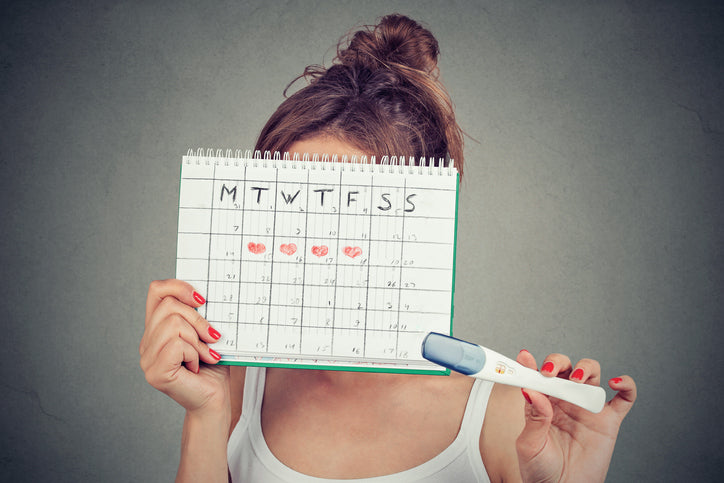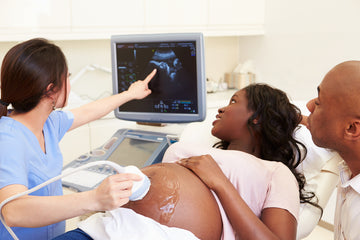The Science Behind Ovulation

So we pop an egg out of an ovary every month and call it ovulation, right?
But what is actually happening inside our bodies?
Whether you have a cycle every 28 days on the dot, or you are less regular and start at random times, it all revolves around ovulation. That little egg is the entire reason we have a monthly cycle!

The Science Behind Ovulating
The hypothalamus, a tiny little piece in the brain that regulates things, monitors the hormone output of the ovaries and synchronizes the normal menstrual cycle. When monthly bleeding ends, the hypothalamus secretes a hormone (GnRH), which stimulates the pituitary gland in the brain to release a follicle stimulating hormone (FSH) and luteinizing hormone (LH). These hormones direct an ovary to start making estrogen (mostly estradiol), and stimulate the maturation of eggs in about 120 follicles.
I’ll break it down: The first follicle that ovulates, releasing its egg into the fallopian tube for a journey to the uterus, quickly changes into the corpus luteum, which is a factory for making progesterone, and raises progesterone's concentrations to 200 to 300 times higher than that of estradiol. This huge surge of progesterone simultaneously puts the uterine lining in its secretory or ripening phase, and turns off further ovulation by either ovary.
If fertilization does not occur (AKA – you do NOT get pregnant), the ovary stops its elevated production of both estrogen and progesterone. The sudden fall in the concentrations of these hormones causes shedding of the blood-rich uterine lining and bleeding (menstruation). Then, in response to low hormone levels, there is a rise in GnRH and the cycle starts all over again. Source
What is the Function of the Ovary?

The ovaries are a pair of female reproductive organs. The size of each ovary is about 1.5 inches long. They are located in the pelvis, one on each side of the uterus. The ovaries are connected to each other by the tubes called fallopian tubes.
The ovaries have two major functions:
- Producing eggs (also called ova)
- Producing female hormones estrogen and progesterone.
Each month, during the menstrual cycle, an egg is released from one ovary. After the egg is released from the ovary it travels to the oviducts, the funnel-shaped ends of the fallopian tubes where it starts its voyage of more than a few days into the uterus. The mature egg is moved all along on its journey through the fallopian tubes by the muscle contractions similar to ocean waves in the fallopian tube. The internal lining of each fallopian tube has cilia, or moving microscopic hairs. (These “hairs” are what aid the sperm to get to the egg to cause pregnancy.) Source
When do I ovulate?
How do I know when I am ovulating?
While most people believe that ovulation occurs on day 14 of their menstrual cycle, it is not always so cut and dry. There are several things to take into account to determine and pinpoint your exact day of ovulation. The best way to do this is to track your cycle in more than one way. Following a Natural Family Planning Method by tracking and charting your changing cervix, cervical fluids, and basal body temperature is the surest way to determine ovulation timing. There are also ovulation kits you can purchase and calendars you can follow, but these methods are far less accurate.
Are ovulation tests reliable?
Ovulation test kits are convenient for the busy woman. You urinate into a cup, dip the strip and wait for a positive or negative answer; however, there is a huge window of error when it comes to these tests.
They may be needed to be taken twice a day to catch the highest rise of lutenizing hormone (LH) before ovulation occurs. The key is knowing that a positive test does not mean ovulation is occurring at that moment, it means the body is “surging” in preparation to release the egg.
The body may have a false surge, where it does not actually release an egg, so relying solely on an OPK may leave you disappointed. The day of ovulation (when a ripened egg bursts out of its follicle) and the five days before it are the fertile window of the female reproductive cycle. The day before and the day of ovulation are the most fertile days; more than 80% of viable pregnancies are conceived on those two days. The length of the LH surge varies from woman to woman, lasting between 10 and 31 hours, which can easily be missed by an ovulation test.
Where does the egg go?
If an egg becomes fertilized, it will take 5-6 days to reach the lining of the uterus and implant within its lining. If an egg remains unfertilized, it travels with the endometrium (thickened uterine lining) as it is shed at the start of the menstrual cycle.What is the Luteal Phase?
The luteal phase is the post-ovulatory portion of a woman’s cycle (or, the time between when you ovulate, and when you get your period). The luteal phase is named for the corpus luteum, which is what’s left of the follicle that was housing the egg that got released at ovulation. The corpus luteum produces progesterone, which your body needs to ripen the endometrium (uterine lining). Progesterone turns the endometrium into a nice soft bed in which a fertilized egg can implant, and a baby can grow. The ripening of the uterine lining happens every cycle after an egg is released, whether or not the egg is fertilized. If the egg is not fertilized, the corpus luteum stops producing progesterone after about 12 to 16 days. Knowing your luteal phase length is important; a LP that is under 11 days generally cannot support a fertilized egg.







